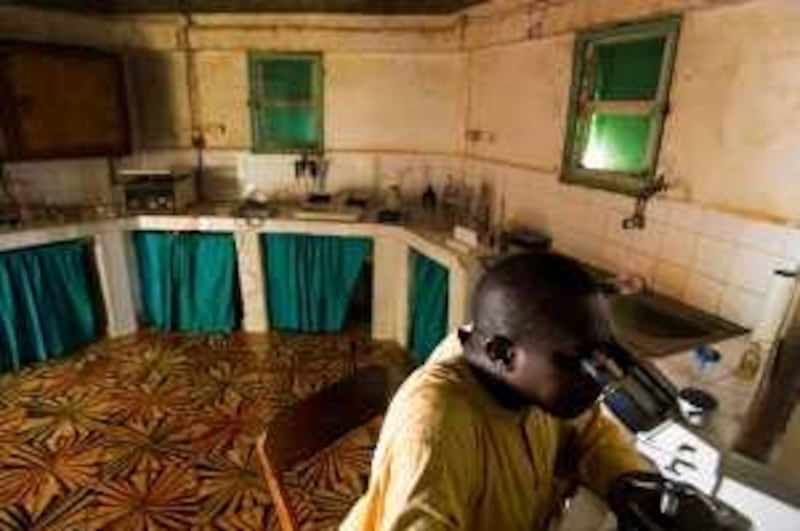FATICK, SENEGAL // Kama Mbagnick does not own a stethoscope, prescription book or even a first aid kit. But his patients travel miles to see him, across countries and even continents, hoping that his organic remedies will cure such ailments as diabetes, severe allergies and back pain.
Once a week the traditional healer travels from the Senegalese town of Fatick to rural areas, where he plucks medicinal plants from the red velvety soil. In recent years the skin on his dark hands has become calloused and tough, the result of picking extra plants to satisfy a rise in demand. Traditional African medicine, once the stuff of legends and nightmares, is gaining a following among middle-class West Africans, some of whom travel from neighbouring countries and even from Europe for treatment at centres like the one in Fatick.
"African medicine used to have a bad reputation," said Emile Niang, who helps the reception desk when he is not working as a lab technician. "Once upon a time it was something that was used to poison people - now people are beginning to take it more seriously." The Fatick hospital is one of the first in the world to bring together traditional healers, psychics and conventional doctors. Patients see a medical doctor to discuss their symptoms, a lab technician to diagnose and a traditional healer or even a medium for treatment. Funding from the World Health Organisation, UN agencies and the Italian government ensures that user fees remain low - and faith in the treatments on offer high.
"Like Chinese medicine, African herbs treat the whole person, not individual symptoms" said Mr Niang, pointing out the lab, prayer room and consulting room - all simple huts with dome-shaped roofs and red marble-effect flooring. "If there's one thing we have plenty of in Senegal, it's time. We dispense a lot of that when analysing a patient." Ndeye Sarr, 25, came to Fatick with bad dermatitis. It was her first time experimenting with traditional medicine, after treatment at a conventional hospital failed. After undergoing analysis in the lab, she met Mr Mbagnick, who ushered her into his consulting room. She looked relieved: the room next door is that of another traditional healer and it is decorated with vultures' heads, crows' feet and the horns of a ram.
After she answered questions about her contraceptive needs - long, thin hoops hang on the wall, to be worn around a woman's hips to prevent conception, Mr Mbagnick, 55, said - Ms Sarr was prescribed a tea made from boabab leaves and bark cuttings. Three months' worth of such treatment costs her 4,000 Central African francs (Dh33), including fortnightly consultations with a medical doctor and Mr Mbagnick. He said he expected her skin to heal within a few weeks.
In one of the huts, Saliou Deme, the psychic, was tidying away seashells, piles of coins and kola nuts. He uses them like tarot cards, throwing them on the ground and analysing the pattern formed. "Each person has four sides," he said, as his mobile phone rang loudly in his pocket. "It's important to look at all of them and protect each corner." Mr Niang confessed that he is tired of the eye-rolling and scepticism lavished upon the town by some tourists. "African medicine is just as effective as Chinese medicine", he said. "The problem is that some people dispense it badly, which hasn't exactly helped its reputation."
Charles Katy, a senior researcher at Senegal's Society for the Promotion of Traditional Medicine, laughed off any scepticism. "Evidence increasingly suggests that African traditional medicine is an excellent tool against some of the worst complaints on the continent. Why import treatments from Europe and North America when we have a wealth of plant remedies here in West Africa? Half of this continent can't afford drugs for simple and common illnesses like malaria, but we have plants that can help us and they are growing on our soil."
Mr Katy said he had kept malaria at bay for 18 years - a rarity in a part of Africa where many people go down with the illness as frequently as the rest of the world catches the flu - by drinking a tea made from a variety of roots and leaves. "Traditional medicine can also heal diabetes, treat things like hepatitis and the symptoms of HIV. "We'd be joking if we thought African medicine can cure Aids, but maybe somewhere out there is a plant that we haven't discovered yet, one that could help."
He added that multinational pharmaceutical companies invested in the search for a plant-based cure-all back in the 1980s. But Mr Katy is concerned that if there is a magic cure for something like HIV among the tall grasses of Senegal's Casamance region or perhaps in the humid forests of neighbouring Guinea-Bissau, it will be lost before it is discovered. The effects of climate change are taking their toll on low-lying countries like Senegal, causing severe flood damage every rainy season and threatening the art of plant picking. Some plants, the healers say, should be picked at sunrise, some at sundown, some in the pouring rain and some after weeks of dryness.
The society has created a botanical garden to help regenerate disappearing species and to satisfy increased demand in the treatments on offer at the Fatick hospital. "We've already lost hundreds of species of plants," Mr Katy said, "and we're only just getting started. It would be a shame to lose all these plants before they've really had a chance to generate an impact." foreign.desk@thenational.ae





